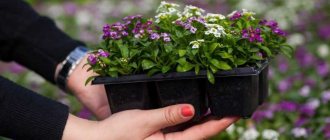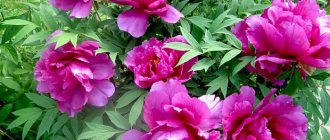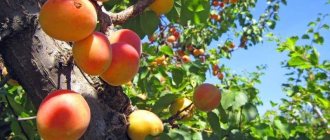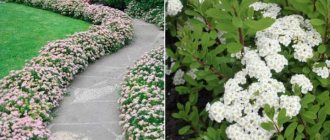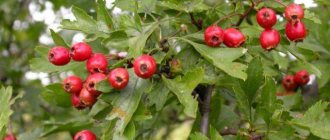Description of perennial gypsophila
Features of growth and flowering
Gypsophila is an interesting plant.
Low, herbaceous, with a branched stem, narrow leaves growing abundantly on the lower part of the stems, and thousands of small flowers collected in panicles. Despite its external simplicity, it harmonizes with plants that have large flowers, and, even growing separately, pleases the eye with its volume and lightness. In addition, gypsophila attracts butterflies. The lack of scale in the ground part, a certain “superficiality” of the plant, is compensated by a solid root that goes to a depth of 70 cm. Gypsophila, despite its external simplicity, takes root for its entire life. The powerful root gives the plant the following features:
- poor sensitivity to dry weather;
- frost resistance;
- Due to the long root, replanting gypsophila is very difficult, so it is planted immediately in a permanent place.
The level of difficulty in growing gypsophila is easy.
Types of perennial gypsophila
Perennial gypsophila has several dozen species. In addition to common species, in nature there are endemics of unique natural reservoirs.
Let's consider the most convenient and promising species for breeding.
Gypsophila paniculata. This is the most famous species. Distributed everywhere, originally endemic to the steppes of Eurasia. In Russia it grows wild in the southern regions from the Volga region to the Chinese border. As you can see from the photo, Gypsophila paniculata has a well-textured appearance.
Characteristics of the type:
- flowers - white, pink (from light to dark), some varieties can change color as the bud opens;
- flowering period - summer, early autumn;
- leaf color – gray-green;
- size of flowers – large compared to other species (up to 0.8 cm);
- height – from 30 cm to 120 cm;
- spread in width – up to 100 cm;
- resistance to frost, drought and other influences – high;
- use - growing in a flower bed, in a flower garden, group growing, cutting for home decor and bouquets.
The most famous varieties of gypsophila paniculata: Bristol Fairy, Pink Fairy, Alba, Flamingo, Rosenschleier, Rosie Vale.
Creeping gypsophila. An unpretentious plant of mountains and rocky European terrain, therefore it can grow in rocky areas. Compared to other gypsophila, this species is a dwarf.
Characteristics of the type:
- flowers - white, pink;
- flowering period - the first half of summer;
- leaf color – dark green;
- size of flowers – small;
- height – from 10 cm to 20 cm;
- spread in width – up to 50 cm;
- resistance to frost, drought and other influences - high, but without cover on rocky areas it can freeze out;
- use – rocky surfaces, lawns.

The most famous varieties of creeping gypsophila: pink, meadow, Fratensis, Monstrosa, Alba.
Gypsophila splinter-shaped. Another mountain species - grows in the Himalayas at altitudes of up to 5 thousand m. A compact, beautiful plant, unpretentious and hardened by the harsh mountain climate. It has a suitable texture for landscape modeling.
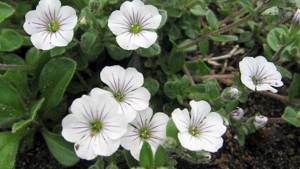
Characteristics of the type:
- flowers - white;
- flowering period - from late spring to mid-summer;
- leaf color – dark green;
- size of flowers – small;
- height – from 10 cm to 20 cm;
- spread in width – up to 30 cm;
- resistance to frost, drought and other influences – high;
- use – rocky surfaces, lawns, mass planting, landscape edging.
Other representatives of gypsophila.
- Arecioid - an unusual plant growing in the mountains of Iran, with compact cushions 3 cm high, flowers - white, frost resistance - low;
- Patrena - looks like a shrub, practically without leaves, the flowers are large, white with a green or purple stripe in the middle, not of great aesthetic value for garden growing;
- Pacific - common in the Far East and border regions of China, tall plant - up to 80 cm, large wide leaves and light pink flowers, the species is frost-resistant. The photo shows that it looks good surrounded by other flowers;
- Uralskaya is a small plant with a modest appearance, flowers are white and pink, grows on the mountains and river banks of the Urals.
Perennial gypsophila: description of the plant
The flower is grown in open ground. Most decorative shrubs grow up to 0.5-1.2 m. But some varieties of gypsophila look like herbaceous creeping shoots from 10 to 20 cm in height.
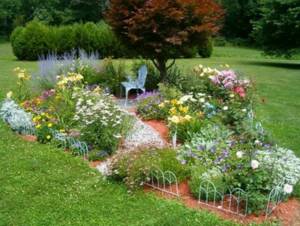
flower composition
The plant tolerates cold winters and hot summers well, loves light very much, does not require abundant frequent watering, and has a powerful root in the form of a branched rod that penetrates to great depths.
The branches, dressed in a smooth green shell, have practically no leaves. The main number of small elongated or rounded leaves are located in the root region and are collected in rosettes. The leaves have pointed ends and solid edges, the color varies from gray-blue to dark green, the surface is smooth and shiny.
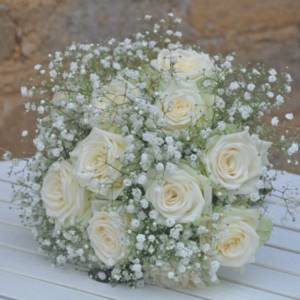
Simple gypsophila flowers
The stems of gypsophila are erect or creeping, thin, and lateral shoots grow very densely on them, so without care and regular pruning, the plant often takes on the spreading shape of a flower cloud. Gypsophila inflorescences are loose, openwork or paniculate semi-umbrellas with simple or double flowers in the form of small bells of white, pink and other shades.
Growing perennial gypsophila from seeds
Preparing the soil and choosing a site for planting
We choose osteospermum as an annual or perennial crop.
Let us give the general requirements of the plant for environmental conditions:
- Illumination – open sun, perhaps light short-term shading during the day.
- The soil is loose, sandy, calcareous; rocky surfaces.
- Soil acidity is non-acidic, up to 6.3 pH.
- Soil moisture – small, dry soil dies from groundwater passing close to the root.
The choice of place for planting gypsophila depends on what type of plant is intended and what goal the gardener is pursuing. For example, gypsophila paniculata is a large plant that has more of a background role in the garden and looks good surrounded by vegetation with larger flowers. Creeping and splinter-shaped - ideal for rockeries, decorating alpine hills, rocky surfaces and rocky slopes. Small species can accentuate the landscape borders of the garden, and can also line the surface like lawn grass.
How to grow gypsophila seedlings
Seeds are planted in closed ground in March. You can take regular soil from the garden or purchase ready-made soil at the store. Given that the plant will have to grow in the garden, some natural soil must be present in the planting soil in any case. Sand and pebbles will not be superfluous. Add chalk to the soil. The soil should not be compacted - gypsophila does not like dense surfaces.
Before planting, the soil is moistened. The seeds are placed directly on the ground; you can symbolically sprinkle the seeds with a very thin layer of earth. To avoid further diving, the seeds should be distributed at a distance of 7-10 cm from each other. Next, the container in which planting occurs is covered with film and left at room temperature.
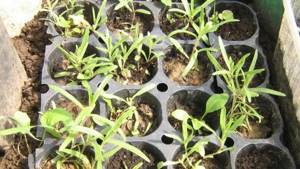
The first shoots appear 2-3 days after planting. The first leaf - after 2-3 weeks. The film should be removed when the seedlings become stronger. Gypsophila needs sun - the seedlings should be on a sunny windowsill. Water as needed. Rooted shoots, like adult plants, do not tolerate excess dampness. A month after planting the seeds, the number of leaves can reach 6 pieces. At the end of April or May, the strengthened seedlings are transplanted to a permanent place in the garden.
Planting seeds in open ground
In general, growing gypsophila seedlings indoors is not important. If there are a lot of seeds, and there is no desire to start seedlings, you can plant the seeds directly in the garden.
If the weather is warm, in the second half of April or May, we prepare the soil in the manner described above, moisten it, mineralize it, sprinkle the seeds with soil, and water it. Within 10 days, sprouts will appear. After 3 weeks, the seedlings are planted, maintaining a distance between shoots of 10-15 cm.
In autumn, young plants are transplanted to a permanent place, maintaining a distance between plants in accordance with their expected size.
Growing gypsophila Snowflake from seeds
The method of reproduction depends on what type of gypsophila we are talking about - annual or perennial. In the first case, only seeds are used for cultivation, in the second, cuttings are also possible. Some varieties are recommended to be propagated only vegetatively.
Planting seeds of perennial gypsophila Snowflake and further caring for it are not difficult. Annual varieties very often propagate themselves, in the same place where they grew. Sowing seeds for cultivation can be done in two ways, again depending on the type of plant:
- annual species are sown directly in open ground;
- perennials are grown through seedlings.
Gypsophila perennial Snowflake is shown in the photo:
Container selection and preparation
Seeds for cultivation can be planted in peat pots, boxes or containers. A loose, light substrate is placed there and watered. If you do not use biostimulants, then before sowing you need to spill the soil with hot water.
Seed selection
If you use your own planting material for cultivation, then the seeds should be cut from the plant before the boxes dry out and turn yellow, and should also be well dried. If seeds are purchased in special stores, then you need to make sure that their expiration date does not expire, because Snowflake’s gypsophila quickly loses its germination capacity.
Substrate preparation
For cultivation, both store-bought and garden substrate are used. Drainage is placed in the seedling container, and a mixture of coarse sand and peat is placed on top. Sometimes purchased soil is mixed with garden soil and lime. When growing in containers, the soil is not compacted too much, and it is well watered before planting the seeds. Gypsophila Snowflake prefers soft and loose soil, with a lot of lime. Such conditions will be ideal for growing it.
Seed sowing scheme
Snowflake seedlings are very sensitive to replanting, so they try not to touch them without reason. To do this, place them in the container at a distance of 10 cm from each other. After planting during cultivation, the container is covered with film or glass. Germinating seeds also need access to oxygen.
Seedling care
The seeds germinate quickly, the first shoots can be observed after 2–3 days. The plant forms a leaf within 15–20 days. When growing, the film from the container is not removed immediately, but when the seedlings become stronger. Water the seedlings as the soil dries out.
The seedlings are transferred to a permanent place when they form 2 full leaves. The weather should be consistently warm. Gypsophila Snowflake can grow in one place for about 10 years, so the growing area for it must be carefully chosen. The place should be well lit, open and without stagnant moisture. Gypsophila does not tolerate even slight shading. It should also be taken into account that groundwater during cultivation should not come close to the surface of the earth.
The soil must contain humus and lime. If the soil is poor in these substances, then they must be added. After the place is prepared, the seedlings are transferred to open ground. Gypsophila is planted at a distance of 1 m from each other, the bushes grow very quickly. The root collar should be slightly above the soil surface. Gypsophila acquires its greatest decorative properties in the 3rd year after planting.
When growing, the Snowflake bush requires pruning, otherwise there is a risk of it turning into a wildly growing weed. Thus, gypsophila can even interfere with other plants in the flowerbed. Pruning is done in mid-autumn, leaving 3-4 stems, shortening them to 7 cm from the root. This procedure also helps gypsophila form young and strong shoots.
The flower overwinters well, but in regions with severe frosts it must be covered with spruce branches and a cap of snow should be formed on top. In spring, the shelter is removed. If you are late with this, you can provoke rotting of the roots due to excess moisture.
When growing the plant, it is necessary to water it only in very dry weather, trying to get it strictly under the root. In other cases, gypsophila feels good without water.
Important! When growing gypsophila, do not feed it with fresh manure; this can lead to the death of the plant.
In the spring, as well as during flowering, the bushes need to be fed with organic matter. Rotted manure or compost will do.
If baby's breath gets too much moisture, it can become sick. The main problems arising in this case:
Gray rot. The leaves turn brown around the edges - this is how the disease begins. Then the gray spots grow. Diseased areas are removed to prevent the rot from spreading further. Treat the flower with Bordeaux mixture.
Smut. These fungi turn the plant into a container for black spores. For prevention, seeds are treated with fungicides before planting.
Rust. When growing, reddish bumps appear on the flower, resembling pads. Gypsophila affected by rust lacks moisture, lags behind in development and does not tolerate frost well. Treatment with Bordeaux mixture helps.
Of the pests, gypsophila is most often attacked by nematodes - root-knot and cyst-forming nematodes. These pests absorb sap from the root system of the plant. Gypsophila slows down its growth, the leaves turn yellow and curl. For the purpose of prevention, when growing, a diseased plant is treated with phosphamide. This must be done several times. If damage to the roots occurs, the bush is dug out of the ground and washed with water at a temperature of 45 ° C. Under such conditions, nematodes die.
Variety of Gypsophila
Perennial flowers for the garden beauty without any hassle 25 photos
There are about 150 species of gypsophila in nature, but only a few are intended for growing in gardens and at home. All plants differ from each other in flowering, petal shade and shape.
Main types of gypsophila:
- graceful;
- creeping;
- paniculata;
- Iliform.
Gypsophila graceful
This is an annual type of plant. An adult flower has a small height. With proper care, it can grow from 40 to 50 cm. It grows in the form of a bush. This species is highly branching. The leaves are very small, lanceolate.
The buds are small. When opened, they reach 1 centimeter in diameter. The flowers can be white or light pink. The buds are collected in wide, spreading panicles. The flowers are placed on thin stalks. Thanks to the small buds, the plant takes on an openwork appearance. You can observe the flowering of Gypsophila graceful for a month or a month and a half.
Main varieties:
- Rose - pink buds;
- Elegance - delicate, white buds.
This species differs from others in its heat and light-loving nature. Therefore, in order for the plant to develop well and bloom profusely, it is necessary to create optimal conditions for it. Gypsophila graceful is a good addition to plants such as godetia and eschscholzia. Gypsophila also looks great with marigolds and other bright flowers. Some florists use this type of plant to create bouquets.
Gypsophila repens
This species belongs to dwarf plants. This is an unpretentious flower that can grow in almost any area. Because of this, it is often called a mountain plant. A peculiarity of this species are the shoots that spread along the ground. The leaves are narrowly lanceolate, small.
The bush is often used to decorate rocky areas and borders.
Main varieties:
- Gypsophila pink. This is a dwarf plant. The main difference is its rapid growth. In a short time, the flower is able to cover a fairly large area. This variety is distinguished by red stems. The maximum height that the plant can reach is 15 cm. The leaf blades are narrow-lanceolate, green in color. The buds when opened have a pink tone. They grow up to 1 cm in diameter. During the year, pink gypsophila blooms twice, the first from June to July, and the second in autumn.
- Gypsophila white. Stems creeping. With proper care, they can quickly form dense bushes. The branches are bare. The leaves are narrow and very small. The plates are dark green. The flowers are white with a pink tone.
Gypsophila paniculata (paniculata)
This type of plant grows up to 120 cm. It is a perennial flower that has an attractive appearance. It is distinguished by knotty stems and strong branching of the bush, especially in the upper part. The leaf plate, as in other species, is very narrow and small. The flowers grow up to 0.6 cm in diameter. The buds when open can be either snow-white or pink. The plant blooms for 40-45 days. You can observe this miracle from July to August.
Depending on the variety, the flowers are double or single. All of them are collected in small inflorescences. At the end of flowering, small fruits in the form of boxes are formed. In the middle of each there are up to 1300 seeds. The grains are very small. Their germination persists for three years. The photo shows gypsophila paniculata, planting and caring for which is not difficult.
Main varieties:
- Gypsophila Snowflake. The bush is quite dense. Its height reaches 10 cm, and its diameter is 50 cm. This variety is distinguished by a large number of small, double flowers of a white hue.
- Gypsophila Rosie Weil. Low growing variety. Its height ranges from 30 to 35 cm. The uniqueness of the plant lies in its flowers. Only the opened buds have a white tint, but over time they become light pink.
- Gypsophila Terry. The buds are snow-white, small.
- Gypsophila Pink Star. The flowers are deep pink, double. The bush reaches 60 cm in height.
- Gypsophila Flamingo. Inflorescences are pink, double. One of the tall varieties. The size of the bush can reach 120 cm.
- Gypsophila Rosenschleier. This plant spreads along the surface of the ground. Its maximum height can be 40 cm. The flowers are double and small. The shade of the buds is pale pink. Flowering duration is from 70 to 90 days.
Gypsophila splinter-shaped
It is a creeping plant that grows up to 10 centimeters tall. Deciduous platinums are ovoid in shape. The flowers are small. Their size reaches two centimeters in diameter. The buds may have a white or purple tint with burgundy veins.
Features of the Gypsophilia plant
Ukrainian Levkoy photo
Gypsophila belongs to the group of ornamental plants. The flower grows in the form of a bush or herbaceous shoot. The root system is well developed. The stems are thin. They have many lateral processes, thanks to which the bush acquires a spherical shape in a short time. The Gypsophila flower grows up to 120 centimeters tall. There are ground cover forms of the plant, the stems of which are located close to the ground.
The shoots of the flower are green. There are practically no leaves on the branches. The main part of the leaf plates is located in the root part. They are lanceolate in shape with a pointed tip. The leaves can have either a dark green or gray tint. The surface is glossy, smooth.
The first flowers can be seen at the end of June. The buds are collected in paniculate inflorescences, which are located at the ends of the shoots. The diameter of the flowers ranges from 4 mm to 7 mm. The most popular types of Gypsophila are presented in the photo:
The use of perennial gypsophila in landscape design
In cultivation, gypsophila is unpretentious and is widely used in landscaping. Gypsophila paniculata L. is very popular among gardeners. A decorative flowering specimen can take the form of herbaceous shoots or subshrubs. The abundance of side shoots gives gypsophila a spherical shape, which is used as an addition or frame to a flower bed. A cut plant can decorate a bouquet made up of large and bright flowers, both fresh and dried.
To decorate the garden, gypsophila can be planted inside a green lawn. The airy haze of inflorescences can become an excellent background for spectacular roses, cannas, and irises, since some flowering crops do not suit a background of bright greenery. Low climbing varieties are used to highlight the landscape boundaries of a garden plot, to design a border, alpine slides or rockeries. Rocky surfaces and rocky slopes strewn with small flowers look beautiful.
Gypsophila in landscape design
Perennial gypsophila looks great with perennials with large flowers:
- phlox;
- roses;
- echinacea;
- godetia;
- liatris;
- monards.
Tall types of gypsophila are recommended to be planted in flower beds and border stones. Dwarf species are suitable for decorating alpine hills, rockeries, and rocky slopes. Any variety of gypsophila fits well with rocky areas and forms a unique landscape.
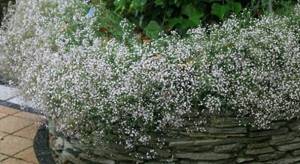
Gypsophila is a universal flower that is easy to propagate and does not require complex care. It will decorate any garden plot, and in combination with other crops it will allow you to create original floral compositions.
You can learn more about planting and care, watering and other nuances of growing Gypsophila in open ground from the following video:
Types and varieties of gypsophila with photos and names
Gypsophila paniculata
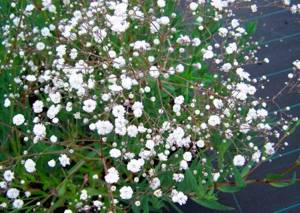
This perennial plant can reach a height of 1.2 m. The bush takes on a spherical shape in a fairly short time. On highly branched shoots there are narrow greenish-gray leaf plates, on the surface of which there is pubescence. The flowers are small (diameter about 0.6 centimeters), they are part of paniculate inflorescences. Depending on the variety, the flowers can be double or single, white or pink. Varieties:
- Bristol Fairy. The bush reaches a height of 0.6–0.75 m, and it bears white double flowers.
- Pink Star. The flowers are double, dark pink in color.
- Flamingo. The height of the bush reaches 0.6–0.75 m. The double flowers are pink in color.
Gypsophila elegans

The plant is an annual plant, its bush is spherical in shape, it reaches a height of 0.4–0.5 m. Its shoots are highly branched, small lanceolate leaves and small flowers, which can be painted pink, white or carmine. They are part of the openwork corymbose panicles. The flowering is lush, but does not last long. Varieties:
- Rose. The flowers are pink.
- Carmine. The flowers are red.
- Double Star. This variety is low-growing, the bush reaches a height of 15 to 20 centimeters. The flowers are deep pink.
Creeping gypsophila (Gypsophila muralis)
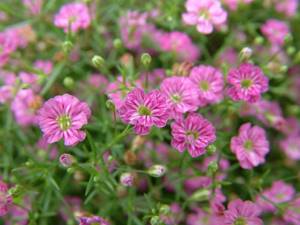
This is a branched annual plant. The bush can reach 0.3 m in height. Opposite dark green leaf plates have a linear shape. The panicles contain small flowers of white or pink color. Varieties:
- Fretensis. The flowers are pink.
- Monstrosa. The flowers are white.
Pacific gypsophila (Gypsophila pacifica)
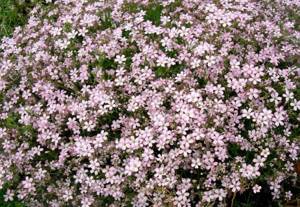
This is a perennial. The spreading bush reaches 100 centimeters in height. The shoots are strongly branched. The lanceolate wide leaf blades are colored bluish-gray. The light pink flowers have a diameter of about 0.7 cm.
Also especially popular are gypsophila yaskolovidnaya, areciformes, tender and Patrena's gypsophila.
Description of types and varieties of gypsophila
In garden floriculture, there are more than a hundred types of gypsophila flowers, which can be grown as both annual and perennial herbaceous crops. As a rule, no more than 15 varieties are actively used.
Also read: Amaranth flower: characteristics of the best types and secrets of proper care
Gypsophila wall
This species is common in European countries. Refers to annual plants. Forms a compact spreading shrub 30 cm high, rich in bright green linear leaves, with white or pale pink flowers. The duration of flowering can be increased by pruning the bush in mid-summer. In this case, it will bloom again. Low-growing shoots, collected into original bushes, are excellent for decorating walls. Looks great in hanging flower pots and in flower beds among a variety of flowering crops. Does well in conditions of regular watering and places partially protected from the sun.
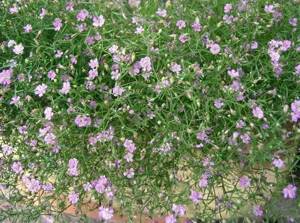
Gypsophila wall
Gypsophila paniculata (paniculata)
A perennial plant with a spherical shape reaches 1 m in height and 1 m in diameter. The openwork is formed as a result of the branching of knotty stems and numerous small panicle inflorescences of a white or pink color palette, especially in the upper third of the bush. Pubescent elongated leaves are formed in its lower part. Depending on the variety, the inflorescences can be simple or double.
Paniculata reproduces in late April and blooms in July. Adult shrubs do not require shelter in harsh winters, unlike young seedlings, which can be covered with spruce branches or wooden boxes.
Gypsophila paniculata includes several varieties:
- Snowflake. Reaches 50 cm. Characterized by densely double flowers.
- Flamingo. The flowering rose bush grows up to 120 cm.
- White holiday. Compact plant with white flowers.
- Pink holiday. Suitable for growing in flowerpots.
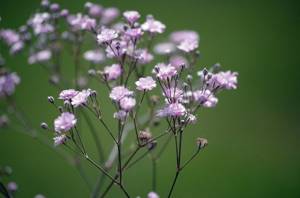
Depending on the garden crop, the shape, color and size of the plant vary. The most used forms include:
- Terry;
- Bristol Fire;
- Rosenschleier;
- Pink Star;
- Rosie Weir.
Paniculata is widely used by florists to decorate dry flower arrangements and bouquets of roses. To grow flower specimens in your own garden plot, it is recommended to provide good drainage to keep the soil dry.
Features of growing gypsophila (video)
Gypsophila terry
A perennial herbaceous plant with small flowers collected in an elegant inflorescence. Used to decorate a garden plot. It can grow in one place for a quarter of a century, while growing rapidly. Flowers bloom in June–July. Although the individual is frost-resistant, it is recommended to cover young seedlings for the winter.
Also read: The best hanging plants for planting in pots
The plant must be sown in April - May in open ground, and 2 - 3 pieces per square meter should be planted on a permanent garden plot. When planting, you should choose well-lit places with dry, permeable soil.
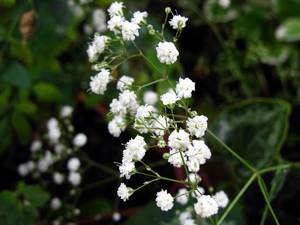
Gypsophila terry
Gypsophila repens
A dwarf species of gypsophila that can grow on rocky surfaces. Due to this feature, the bush is often called a mountain plant. The stem with shoots creeping along the ground reaches only 20 cm in height and 50 cm in width. The plant has narrow, dark-colored leaves and a powerful horse system. White or pink flowers, less than 1 cm in diameter, begin to bloom in the first month of summer. Flowering continues until the end of July. The plant blooms for the second time in the fall . Looks beautiful on lawns and alpine slides.
Gypsophila rose is excellent as a ground cover plant for the foreground of a flower garden. Thanks to the formation of creeping shoots that form dense bushes, a flower cushion 15 cm high is formed.
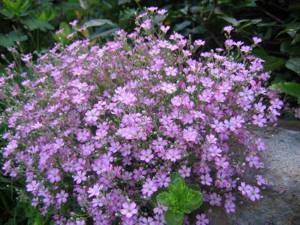
Gypsophila repens
Gypsophila graceful
An annual crop up to half a meter high, it is most often used in flower decoration. It is characterized by a spherical branching structure, especially in the upper part of the plant. The narrow leaves are covered with a waxy coating and are located on smooth stems. Small flowers are connected in corymbose inflorescences, which appear in June - July and fade after 4 weeks. In order to artificially extend the flowering period, it is necessary to sow seeds at intervals of 2 - 3 weeks.
Graceful gypsophila is divided into several decorative varieties:
- Monarch;
- Covent – Gzrden;
- Elegance.
The advantage of this variety is cold resistance and drought resistance. For planting, it is recommended to choose light sandy loam, calcareous, non-acidic fertile soil.
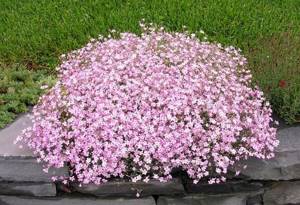
Gypsophila graceful
Gypsophila splinter-shaped
A mountain species native to the Himalayas. Forms 10 cm air cushions. It blooms in late spring with lilac or white flowers with pinkish veins. Unfortunately, the beauty of a blooming crop can be enjoyed infrequently, since it blooms for periods every few years. Prefers to grow on slopes away from the sun.
Also read: What time is it? Ask the flowers! We create a flower clock with our own hands
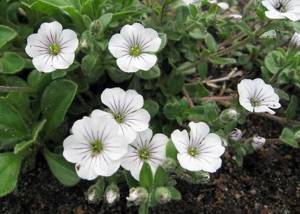
Gypsophila splinter-shaped
Gypsophila pacific
The herbaceous perennial is native to the steppe slopes of the southern part of the Far East. At the end of summer, numerous large pale pink flowers appear, collected in spreading paniculate inflorescences, on branched stems with gray-blue foliage.
It is preferable to plant the plant in loose soil without groundwater. During flowering it looks like a translucent pink cloud. Looks impressive both in the flower garden and as a bouquet cut.

Gypsophila pacific
Gypsophila Pacifica
Decorative flowering plant. Pink flowers are collected in large inflorescences. For good growth it is necessary to create moist conditions. It is important to observe moderation in watering, since flowers die from too much moisture.
It is advisable to plant the plant in illuminated areas of the site. Often used as a decoration for flower beds, borders and natural landscapes.
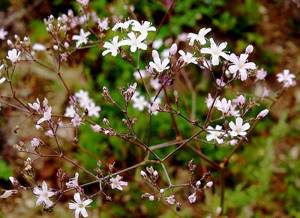
Gypsophila Pacifica
Description of the plant
Kachim (Gypsophila), known as gypsophila, is a species of plant (herb or shrub) belonging to the clove family, which includes about 150 species. Kachim is found in Southern Europe, Asia, North Africa, Australia, Oceania. In its natural state, gypsophila grows on dry hills and rocky areas. The name Gypsophila, translated from the Latin name, denotes the plant's love for gypsum soil.
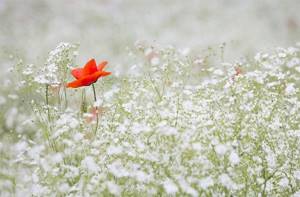
Among gypsophila there are varieties that cover the soil, suitable for rockeries and cut flowers. A characteristic feature and main advantage of the plant is its countless small flowers. The plant bears small, five-petaled, cup-shaped flowers in varying shades of white, pink and light purple. The stems are strongly branched from below.
Underground, kachim forms a network of thickened roots up to 2.5 m long. The roots of the plant contain a lot of saponin and were previously used as a mild detergent, especially for wool. Gypsophila flowers have also been used for medicinal purposes (as an expectorant and diuretic).
In our climatic conditions, Kachim does not winter well, but special perennial varieties can be grown in greenhouses (for wedding bouquets) all year round.
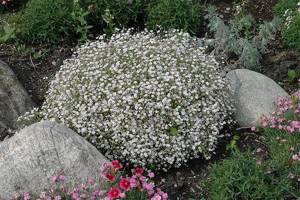
Perennial gypsophila after flowering
Collecting seeds
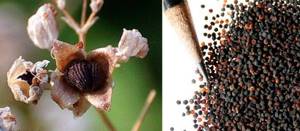
In the autumn, after the bush dries out, in the place where the flowers were, small boxes appear containing small seeds; they are similar in size to brown grains of sand. The boxes need to be cut off. In the room, the seeds are poured from them onto a piece of newspaper. They must be dried and ripened in a ventilated room. Dried seeds should be poured into paper bags or cardboard boxes, where they will be stored.
Wintering
At the end of the autumn period, the perennial gypsophila must be cut off, leaving only 3 or 4 powerful shoots at the root. Then the bushes need to be covered with dried leaves or covered with spruce branches, this will save them during a winter with little snow or during severe frosts.
Basic information about growing
Planting and caring for gypsophila in open ground is not difficult; you need to remember a few basic principles and plant requirements.
When growing tall species, it is worth considering supports in the form of wooden posts to support a very overgrown plant.
Choosing a growing location
Regardless of the type, gypsophila grows best in soils:
- lungs,
- permeable,
- alkaline.
Gypsophila is suitable for cultivation on sandy-loamy or clay-sandy soils with a pH of at least 6.3. Humus and excessively moist soils are not suitable.
You need to prepare a sandy substrate, you can even add small stones. This will ensure good drainage of water during a rainstorm, and the plant will not remain flooded.
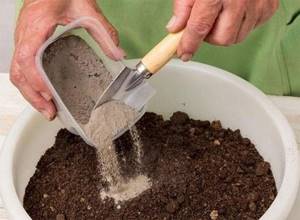
Gypsophila prefers sunny, warm places - planted in the shade under a tree, it may weaken and not bloom. This is a very light-demanding plant. The length of the day, an important factor for generative development, is 13-16 hours, depending on the variety.
Gypsophila can decorate unattractive places, crevices, rocky corners of the garden with very poor soil. Protection from wind, which can damage the delicate plant, is important.
Temperature requirements
| Index | °C | |
| Minimum temperature required to initiate flowering | 12 | |
| Optimal – during the growing season | during the day | 27 |
| at night | 22 |
Propagation, sowing and planting
Gypsophila seeds can be sown directly into the ground in March and April, or seedlings can be prepared in advance. The distance between plants is approximately 50 cm.
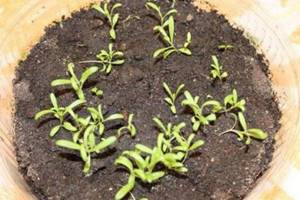
Gypsophila seedlings
Gypsophila is propagated:
- seeds;
- division of adult, overgrown kuts;
- cuttings.
In the case of sowing annual gypsophila, the seeds are sown in early spring, April is recommended. It is worth considering growing under a film that protects the plant from possible spring frosts.
Sowing seeds of perennial gypsophila species occurs differently. With the onset of spring, the seeds are sown in an unheated greenhouse. With the onset of summer or the beginning of autumn, gypsophila is transplanted into open ground. Young gypsophila can be planted in beds in mid-April at intervals of 60 cm, but it must be covered until mid-May.
Another way to propagate gypsophila is to divide a very overgrown bush - the so-called propagation by root cuttings. Only Gypsophila paniculata reproduces in this way.
Watering and fertilizers
Gypsophila does not tolerate excess water. Watering too often and too much can lead to the death of the plant. When it comes to fertilizers and watering, gypsophila has no equal: you don’t need to worry about watering and fertilizing. Only during long periods of drought can the plant be watered sparingly.
There is absolutely no need for fertilizer. Only in the case of perennial varieties, after the first year should the flower be fed with a dose of nitrogen, calcium and potassium. In the second year in the spring, add 40 g of nitrogen per 1 m² after the main flowering. The dose of potassium and calcium may be higher.
Collection of flowers for bouquets
The shoots are pruned when 1/3-1/2 flowers develop. From 1 m², 120-200 shoots of inflorescences are collected. Flowers can be stored in glass containers with water in a room with a temperature of 4 °C for a week. Gypsophila flowers can be dried, especially when the shoots are saturated with glycerin after cutting.
Wintering
Most varieties are annual and are not intended for wintering. Perennial gypsophila has difficulty overwintering in our climatic conditions; the plants do not tolerate low temperatures and frosts. Excess humidity is especially dangerous for it during the winter months.
Healthy plants of perennial varieties can overwinter, but in cold and snowless winters they should be protected from freezing with the help of dry leaves and branches of coniferous trees. If the plants are not soaked with water, there is a good chance of developing new shoots in the spring.
Diseases and pests
Gypsophila rarely gets sick. The cause of diseases is usually excessive moisture, leading to rotting of the stems of seedlings and young plants. In older plants, overwatering causes root rot. In both cases, the plants cannot be saved.
The plant needs to be monitored. Sometimes gypsophila becomes a victim of snails and slugs. Pests especially like to feed on young shoots.
(4 ratings, average 5 out of 5)
Growing from seeds to seedlings
You can buy many types of perennial gypsoflora in stores. But you can collect the seeds yourself from the flowers growing on the site. Experienced gardeners recommend propagating perennials through seedlings. Sowing seeds in pots can be done as early as March.
Soil and container
For planting you need to prepare small trays and flat pots. The material of the planting container can be different: clay, plastic, peat, wood. There must be drainage holes at the bottom.
Pour porous soil into containers with the addition of lime or chalk. You can place expanded clay and pebbles on the bottom as drainage. Sow the seeds to a depth of 0.5 cm, keeping a distance of about 10 cm between them. Water the crops, cover with glass or film and place in a bright, warm place.
Seedling care
To germinate seeds, it is necessary to keep the boxes with crops at a temperature of +15-22 degrees. Shoots will appear in approximately 2-3 days. While the seedlings are young, they need to be provided with additional lighting so that daylight hours last at least 13 hours. After a couple of weeks, when 2-3 true leaves have formed, the seedlings need to be thinned out. This will make it easier to transplant them into peat pots. Water the seedlings as needed.
Transplanting
You can grow seedlings in pots until autumn. It will have time to get stronger and take root. And it will be easier to settle down in a new place. Some sow seeds for seedlings before winter. In such cases, it is planted in open ground in the spring with the onset of stable warm weather.
Prepare the area in advance. The soil needs to be loosened, mixed with sand and fine gravel. You can add lime. Dig holes and place drainage at the bottom. Remove the seedlings from the container along with the soil and place them in the hole. Sprinkle with soil so that the root collar is on the surface. Be sure to water the plant at the root.
It is not recommended to apply liquid fertilizers during planting. If you plan to plant several perennial bushes, then you need to maintain a distance of 0.2-1 m between them, depending on the variety. Dwarf gypsofloras are planted closer to each other, tall ones - further away.
How to grow annual gypsophila from seeds
Annual individuals, unlike perennial varieties, reproduce only using seeds. The process should begin in early spring or before winter. Seeds must be sown in April in special seedling containers and covered with glass. After the seedlings have grown (after 2 weeks), the sprouted seeds should be thinned out, ensuring that there is a gap of 15 cm or more between the seedlings. Then they are transferred to a new place, where they will grow constantly. At the same time, no more than 3 seedlings must be planted per square meter, otherwise the overgrown bush will drown out the individuals growing in the neighborhood. After 3–4 years, a plant grown from a seed will become decorative.
Gypsophila and its varieties
This flower is unpretentious and does not require special care. It looks very nice, although the flowers are quite simple and may seem inconspicuous. But there are a lot of them on the bush, and they form a lush snow-white cover. Gardeners love gypsophila very much and choose it due to the following qualities:
- It spreads pleasantly along the ground, and you can see many different butterflies on it.
- It is a good decorative element of a flower bed or plot.
- It is a very lush and light flower and looks special.
There are many varieties of this plant in nature, but among those that are preferable for growing and breeding are the following:
- Gypsophila paniculata. The most famous variety. It has gray-green foliage and white or pinkish flowers. The flowers are quite large, their size is almost a centimeter. Blooms throughout the summer season until September. The height of the bushes varies and can vary from thirty to one hundred and twenty centimeters. The height of the bush depends on the care provided and what type of fertilizing is used. When gypsophila paniculata is planted and cared for properly, the bushes will be lush and bloom abundantly.
- Gypsophila splinter. Perennial plant type. It's a pleasure to grow. It is very beautiful and belongs to the mountain species. It has a luxurious structure and is perfect for landscape modeling. This variety is unpretentious and frost-resistant, easily tolerating arid climates. All this goes perfectly with external beauty. This variety reaches only 10-20 centimeters in height and has small white flowers. Perfect for creating landscape edging, decorating rocky surfaces or improving the lawn.
- Gypsophila repens is a dwarf variety that grows in mountainous areas. This makes the flower the most unpretentious of all varieties. Breeders call it that - a mountain plant. The low-growing flower is covered with flowers of white and pinkish shades, which are framed by rich green leaves.
- Gypsophila graceful. This variety belongs to the annual plant species. The bush itself has a spherical shape and thin branched stems. The foliage is lanceolate and the flowers are delicate and can be pink, white or cream. Such a bush can reach up to 50 centimeters in height.
Planting a plant
Although gypsophila is an unpretentious shrub, before planting you should take responsibility for the planting site and the soil on it. The soil must be loose and have drainage. It is better to choose sandy, dry soil where groundwater is far away. Otherwise, the branches may die from these waters. A rocky type of surface is also good.
Before planting, the soil should be moistened. Then the seeds are placed in it and a thin layer of earth is sprinkled on top. You should maintain a distance between seeds of approximately ten centimeters, no more. First, the seedlings are sown in a box. It must be covered with film on top and placed in a sunny place for several days. After three days, the first shoots can already be observed. And in a couple of weeks the first leaves will begin to appear. In May, when the seedlings are strong enough, they can be transplanted into open ground.
Rules of care
As already noted, gypsophila is very unpretentious. It only requires proper timely watering, weeding from time to time and periodic feeding. If the summer is dry and hot, then watering should be plentiful. Water the flower at the root; this should be done in a timely manner. You should also ensure that there is no stagnation of water.
Gypsophila is fed infrequently. This is usually done twice a season using mineral fertilizers. When the plant has enough warmth and sunlight, it can do without additional fertilizers. Mullein infusion is good for these purposes, but fresh manure can destroy the flower.
Caring for perennial gypsophila
How to make supports for an adult plant
If we grow gypsophila paniculata or other tall species of this plant, then under the weight of the stems they have the habit of bending in one or more directions. This significantly reduces the visual effect, violating the overall proportions of the “blooming cloud”, forming voids in it. To prevent this from happening, additional care is required in the form of installed wooden supports. These can be supports in the form of a slingshot or U-shaped supports - depending on the size of the plant, the degree and direction of its “collapse”.
The supports will disappear as the plant continues to grow and flower.
How to prune a bush in autumn
Gypsophila is not a shrub, but a herbaceous plant. After the end of the growing season, i.e. After it fades and the stems dry out, pruning is required. As a rule, this happens in mid-October. The stems are trimmed in such a way that the remaining dry stems are no more than 5-7 cm in height.
Preparing for winter
Gypsophila is a frost-resistant plant that takes deep roots and therefore, as a rule, does not require special preparation for winter. There is an opinion that some less common varieties need to be specially covered for the winter: with burlap, rags, and tree bark. This can be done for the purpose of insurance, in particular when it comes to young plants that have not yet had time to take root properly, as well as those that are not frost-resistant.
The best shelter for gypsophila is snow cover. If there is not enough snow, it needs to be replenished.
Gypsophila propagation
The best option for propagating gypsophila is to obtain seedlings by planting seeds. Practice shows that this is the simplest and most effective method.
In addition to growing from seeds, perennial species can be propagated in the standard way, by rooting parts of an adult plant. Before the flowering period, at the end of spring, the top 5-8 cm long is cut off from the stem. The soil is prepared in special containers for rooting: it is loosened, pebbles, lime, sand are added - it is brought closer to the option on which the plant will grow in the future.
Before rooting, the soil is well moistened. The cuttings are slightly immersed in the ground. Pots with cuttings are placed in a warm, bright place without sunlight. Some gardeners advise covering the cuttings with film for a greenhouse effect. However, for proper development, the plant must breathe: covering the cuttings with film does not guarantee their better survival rate. The plant will take root in 2-3 weeks and will take root completely 1-2 months after planting. At the end of summer, rooted young shoots need to be moved to open ground to a permanent place.
Caring for gypsophila in the country
Thanks to the powerful root system, which develops throughout most of the plant’s life, unpretentious gypsophila is resistant to cold and drought. Caring for gypsophila is quite simple. Therefore, they are happily grown by summer residents who visit their suburban homes on short visits and cannot provide the crops grown in their dachas with regular watering and proper care.
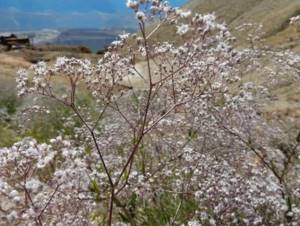
Unpretentious gypsophila
Rules for watering a flower cloud
Plants are watered rarely, but the soil is not allowed to dry out.
During drought, up to 3 liters of liquid that does not contain impurities and chlorine are poured under one bush. Use spring, well, rain, and settled tap water.
The water temperature should not be lower than the ambient temperature. Gypsophila does not like surface watering, so water is poured under the root.
Top dressing
Fertilizing is carried out no more than 3 times during the flowering season. Potassium fertilizers can be alternated with organic ones - herbal infusions, ash extract.
Ash contains a large amount of potassium, calcium, and other trace elements. To fertilize, use a glass of wood ash sifted through a sieve, which is poured with boiling water and allowed to brew for 3 days. Then the liquid is filtered. Clean water is added to it. The total amount of water should be 10 liters.
Important! The use of manure is not recommended for feeding gypsophila.
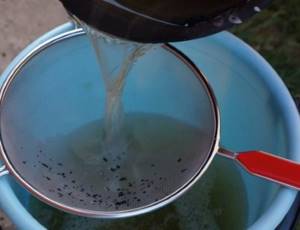
Feeding with ash




